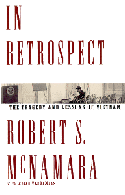 |
IN RETROSPECT:
|
 |
IN RETROSPECT:
|
A brief sketch of my life from birth, June 9, 1916, to the day I became President John F. Kennedy's secretary of defense, January 20, 1961. I explain how I came to that post and the beliefs and values I brought to it.
The Kennedy administration's decisions relating to Vietnam from the time of a critical meeting with President Eisenhower the day before JFK's inauguration, through the political crisis that erupted in Saigon in the summer of 1963. The chapter outlines the assumptions behind the administration's decision to increase sharply U.S. involvement in Vietnam. It stresses the two contradictory premises that underlay that commitment: the fall of South Vietnam to Communist control would threaten the security of the West, but the U.S. military role would be limited to providing training and logistical support.
A pivotal period of U.S. involvement in Vietnam, punctuated by three important events: the overthrow and assassination of South Vietnam's president Ngo Dinh Diem; President Kennedy's decision on October 2 to begin the withdrawal of U.S. forces; and his assassination fifty days later.
The chapter opens with a statement of what I believe President Kennedy would have done in Vietnam had he lived. It then describes the subtle, incremental, but crucial slide toward deeper involvement in Vietnam during the first eight months of the Johnson Administration. After Diem's death, we confronted an unraveling political situation in Saigon, along with growing demands for more U.S. military action.
The closest the United States came to a declaration of war, the Tonkin Gulf Congressional Resolution of August 1964 generated intense controversy and enduring questions: What happened? Why? What were the consequences? What should have been done differently? This chapter addresses those questions by describing what transpired in the Tonkin Gulf; why the Johnson administration acted as it did; why Congress quickly and overwhelmingly approved the resolution: and how LBJ and his successor, President Nixon, subsequently misused it.
As the Johnson administration's policy on Vietnam drifted during the 1964 presidential election, military and political conditions in South Vietnam rapidly worsened, heightening the dilemma between avoiding direct U.S. military involvement in the conflict and avoiding the loss of South Vietnam to communist control. Deep divisions developed within the American government, and the Pentagon itself, over what to do in the face of an increasingly difficult and dangerous problem. Events reached a critical juncture when we faced a choice among unpalatable alternatives at the beginning of 1965.
The most crucial phase of America's thirty-year involvement in Indochina, the six months between January 28 and July 28, 1965, saw the United States embark on a course of massive military intervention in Vietnam, an intervention which ultimately destroyed Lyndon Johnson's presidency and polarized America like nothing since the Civil War. How did it happen? Why did we fail to foresee the implications of our actions? What hopes, fears, perceptions, and judgments--accurate and inaccurate--shaped our thinking and actions? This chapter gives answers to these and other often-asked questions.
Reality collided with expectations. Slowly and gradually the sobering, frustrating, tormenting problems and limitations dogging our military operations in Vietnam became painfully apparent. The growing realization of these difficulties led to proposals for further escalation which in turn, increased the pressure for a diplomatic resolution of the war. This culmination in a highly controversial month-long bombing pause at the end of 1965. But Hanoi and the Vietcong responded negatively, and 1966 began with pressures for an ever-widening war.
Between late January 1966 and mid-May 1967, the war and its casualties grew substantially; debates over ground strategy, pacification, and especially bombing intensified dramatically; and war-related pressures on the Johnson administration, my family, and me increased almost daily. Public support remained strong but dissent began to grow. Three further sporadic, amateurish, and ineffective attempts to start negotiations failed. The period ended with still another request from General Westmoreland to increase U.S. troop levels. And underlying it all was the growing gap between the president and his secretary of defense, a gap crystallized by a memorandum from me to President Johnson on May 19, 1967.
My May 19, 1967 memorandum triggered a storm of controversy. It intensified already sharp debate within the administration. It led to tense and acrimonious Senate hearings on the bombing that pitted me against the Joint Chiefs of Staff. And it accelerated the process that ultimately drove LBJ and me apart. A deluge of other crises taxed the already strained government: a Mideast war leading to the first use of the "hot line" between Moscow and Washington; racial rioting in major American cities; rising public unrest culminating in a massive attempt to shut down the Pentagon. Carrying my thoughts of May 19 further still, I gave President Johnson another memo on November 1 that brought the difference between us over Vietnam to the breaking point.
Reflections on the war: With hindsight, was the U.S. wise to intervene militarily in Vietnam? What mistakes did we make? What lessons can be learned? And how can those lessons be applied to the present and the future?
On several occasions during the Vietnam War, the Joint Chiefs of Staff recommended actions which they stated might lead to the use of nuclear weapons. And recent disclosures have shown that during the Cuban Missile Crisis in 1962, the United States, the Soviet Union, Cuba, and indeed the world came much closer to nuclear disaster than was realized at the time. There is today both a growing recognition of the lack of military utility of nuclear weapons and a heightened understanding of the risks associated with their continued deployment. As a result, more and more security experts are urging that nuclear arsenals be reduced below the levels agreed to by President Bush and Yeltsin. Some are urging we return, insofar as practicable, to a non-nuclear world.